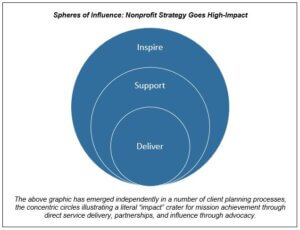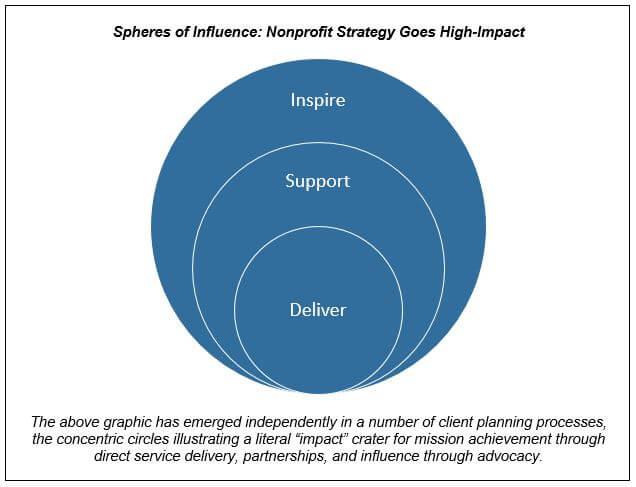Seven Success Factors for Adopting an Advocacy Strategy
How can nonprofits successfully navigate the transition from a traditional direct-service role to advocate for systems-level change? This post describes key conditions for effective advocacy.
The most effective nonprofits operate at multiple levels of influence.
In Forces for Good, Leslie Crutchfield and Heather McLeod-Grant revealed their research finding that “high-impact nonprofits work with and through other organizations and individuals to create more impact than they could have ever achieved alone.” These organizations work beyond their own walls to change the world around them.
Today — five years later — this may not be big news. But here at La Piana, we have recently noticed a marked uptick in clients embracing and adopting advocacy strategies to extend their reach and enhance their impact. From youth development organizations to environmental groups, and everything in between, more nonprofits are demonstrating a readiness to expand their spheres of influence through policy advocacy.

But mere readiness isn’t enough. How can nonprofits successfully navigate the transition from a traditional direct-service role to effectively advocate for systems-level change?
Below, we describe seven conditions for success, or prerequisites, for effective advocacy:
1) The organization has a proven track record of delivering direct services. In Forces for Good, the authors refer to the virtuous cycle of serving and advocating. Many organizations start out as service providers and become advocates; others start out as advocacy organizations and then develop services. The most effective advocacy organizations have viable service delivery programs that give them direct experience with their constituency. A successful track record of service delivery — one that creates sustained positive outcomes — can supercharge advocacy by strengthening the moral authority of the organization, bolstering its expertise, and building a broader constituency. The advocacy organization that is rooted in effective service delivery can inform policymakers with hard data about community issues and effective interventions, as well as powerful stories of lived experience. Often these organizations can provide access to people who are most impacted by social problems, public policy, or both. A recent La Piana client that focuses on youth development exemplifies this principle, having just articulated a strategy of first demonstrating outcomes in a handful of major U.S. cities before engaging in advocacy to influence public policy to support youth.
2) The organization has a solid base. To be effective in advocacy, nonprofits must have more than moral authority — they have to have a broad base of support. Organizations like the American Cancer Society understand the importance of mobilizing a base to support public policy. They establish public policy advocacy communications channels to encourage broad pressure on policymakers from the grassroots. Oftentimes the base is created for the specific purpose of grassroots advocacy. But the most powerful grassroots base is often the organization’s donor base: they are one and the same. With this in mind, many powerful advocacy organizations cultivate their base in a way that continually educates donors about the broader public policy context of the organization’s work and the impact of policy on the lives of those they serve. Groups like Surfrider, AARP, the NRA, and the Sierra Club are all organizations that inform and mobilize a base that helps them financially while providing the broad political support for policy initiatives.
3) The organization’s leadership is committed to advocacy. The organization may include many willing advocates on staff, but without leadership at the board and senior staff level, it will not be able to summon the collective political will to advocate forcefully. Lack of leadership buy-in for advocacy can stem from a number of sources: differences of opinion about the proper role of public policy in advancing public benefit (e.g., free market approaches to health care v. Medicare for all); lack of understanding of the regulatory limits on nonprofit advocacy; and the stage of the board’s life cycle (operating boards, focused on service delivery, are often not predisposed to engage in policy advocacy). The leadership problem for governing boards can be exacerbated when there has been a deliberate and successful effort to build potentially diverse board membership. In these instances, public policy advocacy may be seen, at a minimum, as a threat to group cohesion and, potentially, disruptive to the point of keeping the board from addressing other important board business. For one recent client struggling to find its role around environmental advocacy, one solution was to elevate the conversation to a consideration of core principles and/or unique competitive advantage — in this case, the belief in the primacy of scientific method. In the end, most board members agreed enthusiastically that promoting policy based on sound science was above political ideology.
4) The organization budgets for advocacy. Many organizations don’t budget for advocacy or don’t budget in a realistic way. If the approved annual budget doesn’t include a specific line item for advocacy activities, the organization cannot realistically hope to devote staff and other resources to advocacy. Organizations often have a significant “Aha!” moment when they first learn about the limits on expenditures established by the IRS for organizations that opt to file the 501(h) election. Under these “restrictions” a nonprofit with a budget of $1 million could devote up to $175,000 to public policy advocacy. That’s no small potatoes! While, for most nonprofits, this would be sufficient for building an advocacy program to augment its service delivery, many might balk at diverting that kind of money away from direct service. Still, much can be done with a small advocacy budget, and it needn’t always draw resources away from other priorities. For information about the state of funding for advocacy, check out the resources produced by the Atlas Learning Project, which include information about legal and policy advocacy, support for capacity building, and use of the 501(c)(4) structure. Offering a specific example of advocacy success with a modest budget, Heather McLeod Grant and Leslie Crutchfield cited the case of Regional Youth Adult Social Action Partnership (RYASAP), a $3.2 million organization based in Bridgeport, Connecticut in Local Forces for Good (SSIR, Summer 2012). RYASAP received seed funding from a local family foundation to support advocacy within a cross-sector coalition of partners. The result was an impressive series of reforms to the juvenile justice system in Connecticut.
5) The organization has articulated an advocacy theory of change. Particularly for those nonprofits seeking outside funding for advocacy, thinking through a theory of change can make a big difference. It’s always a good idea to understand the rationale behind a particular strategy, but it’s even more critical if you’re trying to sell your approach to others. While the theory of change behind direct lobbying may be relatively simple, other approaches to advocacy can be more complex. For example, if your strategy involves research to influence public policy or community organizing to build a grassroots base, you’ll need to clarify how these approaches will actually result in a desired outcome (e.g., policy debate, policy formation, or passage of legislation). Foundations often require nonprofit partners to articulate a theory of change for programs, and it won’t be long before they’ll all be asking for something similar in order to support advocacy work. Some already are. For example, in Advocacy Isn’t Soft (SSIR, Spring 2014) Marc Holley, Matthew King, and Mindy Hightower examine the growth trajectory for the Western Family Foundation in evaluating grants to support education advocacy work.
6) The organization’s structure is conducive to advocacy. Some nonprofit boards are appointed rather than elected. This is common for organizations chartered to support a particular government funding stream (think Head Start organizations, Community Action organizations, or First 5 in California). With a board that is comprised of appointed members, particularly if some of those members are either government officials or their appointees, the organization may not be able to effectively advocate in the public policy arena. Having a single government funder (or a handful of institutional funders) can also be a structural obstacle because the funding structure doesn’t include a broad base of community support that can be harnessed for effective public policy advocacy. In his article, The Secret of Scale (SSIR, Fall 2013), Peter Murray captures the essence of the problem of developing and maintaining a base: “Most civic organizations struggle to reach beyond the same core group of activists to more deeply engage members who are often little more than names on mailing lists. Instead of developing a broad donor and revenue base, many civic organizations have become overly-dependent on big grants from foundations, large donors, and government….”
7) The organization engages allies in its field. Going the advocacy route alone isn’t nearly as powerful as addressing policy collectively as part of a coalition. Partnerships for public policy advocacy face many obstacles. While having multiple voices encouraging policy change can have great impact, building consensus about policy recommendations among organizations that are often competitors for attention or funding can be a challenge. Trust between organizational leaders is essential to forging effective public policy alliances. Building this trust takes time, committed effort, and a willingness to publicly acknowledge the contributions of other organizations working in a particular field. As Sushma Raman noted in her piece Focusing on Advocacy (SSIR, Fall 2011), “Bringing together diverse institutions, strong leaders, and varying theories of change can make collaboration messy and slow. Yet the long-term benefits can be worth it.”
Have you thought about how advocacy could accelerate your mission impact?
Please share your thoughts, experiences, and questions in the comments section below. We’d love to hear from you!


Comment section
1 thought on “Seven Success Factors for Adopting an Advocacy Strategy”